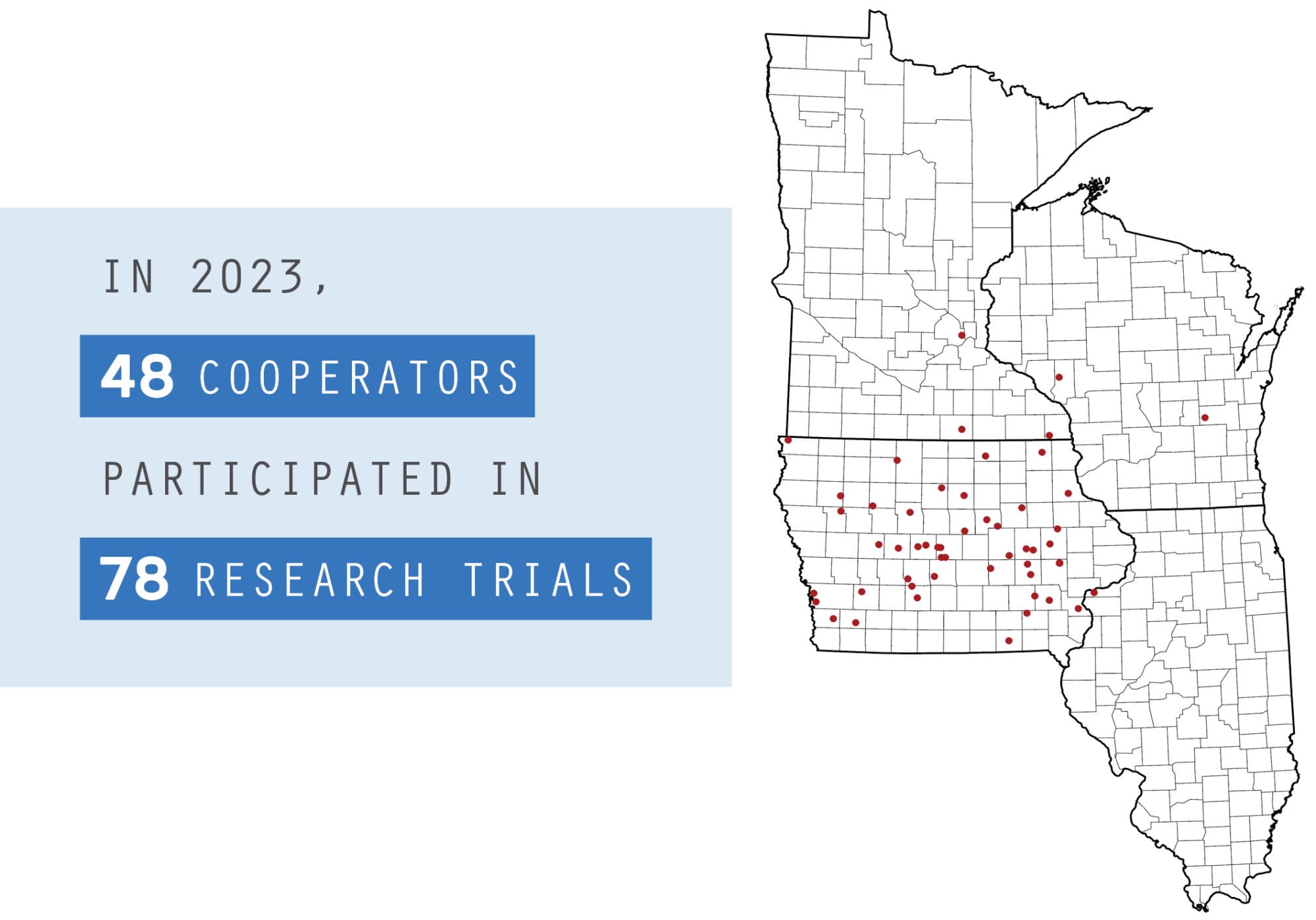2023 Cooperators’ Program Report
Dick Sloan was in a reflective mood this past winter as farmers were starting to plan on-farm experiments for 2024. A long-time participant in the Cooperators’ Program, Dick took part in 25 on-farm trials, mostly on cover crops and diversified crop rotations, between 2013 and 2022.
Now retired from farming, Dick no longer conducts trials. But the spirit of the program has remained palpable. Reflecting on his time as a cooperator, he summed up what the Cooperators’ Program is all about – “doing good science,” as he put it, alongside others.
“All of us caring together makes us stronger and more independent together,” Dick says. This synergy is the ultimate outcome of working with and learning from other committed farmer-researchers. Dick’s words also perfectly describe two core aspects of the Cooperators’ Program: collaboration through science.
We believe in working together to design relevant, rigorous on-farm experiments to advance farmer-ownership of research conclusions and created knowledge. The program attracts those who desire a framework for being intentional about improving their farms and working with others to explore ideas.
The on-farm experiments explored in the Cooperators’ Program emerge from the many desires and curiosities of PFI members. Because of the wide array of field crop, vegetable and livestock enterprises in our midst, one might suppose such diversity results in a hodgepodge of on-farm research projects.
While it’s true that farmer-cooperators have myriad ideas and strategies they’re curious about, research themes inevitably crystallize and emerge through the process of collaboration. This was true of 2023 research projects, too, which reflect themes that transcend enterprises.
As you’ll read, both field crop and vegetable farmers assessed strategies for terminating cover crops without tillage or herbicides. Fred Abels, Jon Bakehouse, Keith Gorham, Kevin Veenstra and Michael Vittetoe found some success using roller-crimpers on cereal rye ahead of soybeans.
Meanwhile, smothering cover crops with tarps for various lengths of time revealed important lessons for organic vegetable farmers Hannah Breckbill and Emily Fagan. “Three weeks is a really ideal amount of time to leave a tarp on,” Emily says, “but two weeks will do in a pinch.”
Soil health and fertility were on the minds of many cooperators in 2023. Several corn farmers found they could reduce nitrogen fertilizer rates and save money in fields they’ve been improving with cover crops over the years. Kate Edwards, Jason Grimm and Terry Troxel were curious how their potatoes would respond to various organic fertilizers.
Both corn and vegetable farmers tested alternative soil amendments to traditional fertilizers. Some worked better than others. Kate Solko and Kyle Maxwell, who farm next to a brewery, found that what is commonly considered a waste product from brewing beer (spent grains) increased eggplant yield.
Ultimately, the scientific experiments done in PFI’s Cooperators’ Program impart the power to independently judge a practice and confidently decide whether to adopt it for oneself. And mirroring Dick’s comments, those who conduct the experiments tell us this power is amplified when done within a community of caring and curious individuals who inspire one another.
You’ll learn more about the projects mentioned above, and others, in the summaries that follow. If you’d like a printed copy of any research report, please contact us.
download the 2023 Cooperators’ program report
Soybean Maturities in Delayed Termination Rye
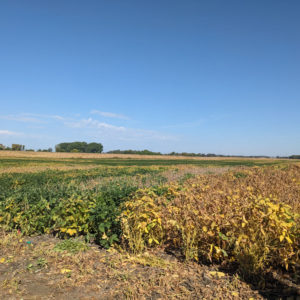 Planting green is a practice where farmers plant soybeans into a growing cereal rye cover crop and terminate the cover crop after the soybeans have emerged. This practice maximizes cover crop growth and its ability to suppress weeds. But delaying termination by more than two weeks after soybean planting can lead to lower soybean yields.
Planting green is a practice where farmers plant soybeans into a growing cereal rye cover crop and terminate the cover crop after the soybeans have emerged. This practice maximizes cover crop growth and its ability to suppress weeds. But delaying termination by more than two weeks after soybean planting can lead to lower soybean yields.
Alec Amundson, Landon Brown, Jeremy Gustafson, Ross McCaw, Scott Shriver and Tracy Skaar decided to test if planting later-maturing soybean varieties can prevent yield decline when planting green and delaying rye termination. They each planted an early- and late-maturity soybean variety (average of 0.8 relative maturity groups different) into green cereal rye and tested two different cover crop termination timings (near-plant vs. delayed).
Cooperators waited an average of four days after soybean planting to terminate rye in their near-plant termination treatment and an average of 21 days after planting to terminate rye in their delayed-termination treatment.
Fall Cauliflower Variety Trial
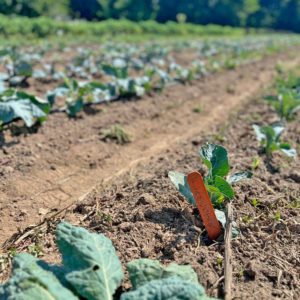 Timing the fall planting of cauliflower and other slow-maturing crops is often difficult, especially when planting a new variety. Many cauliflower varieties are available to farmers in an array of colors, plant and head sizes and average days to maturity. Building on several past PFI studies, a group of cooperators evaluated seven cold-tolerant cauliflower varieties planted as fall crops to see how each performed. They also hoped to use the present trial to gauge customer interest in novel cauliflower colors.
Timing the fall planting of cauliflower and other slow-maturing crops is often difficult, especially when planting a new variety. Many cauliflower varieties are available to farmers in an array of colors, plant and head sizes and average days to maturity. Building on several past PFI studies, a group of cooperators evaluated seven cold-tolerant cauliflower varieties planted as fall crops to see how each performed. They also hoped to use the present trial to gauge customer interest in novel cauliflower colors.
Castration Timing in Goats and Sheep
 Kid and lamb castration timing may affect animal health and wellbeing, final hanging weights and labor timing and costs. Farmers commonly castrate animals when they are anywhere from one or two days old to several months old, and there are currently no set regulations or best-practice recommendations in the U.S.
Kid and lamb castration timing may affect animal health and wellbeing, final hanging weights and labor timing and costs. Farmers commonly castrate animals when they are anywhere from one or two days old to several months old, and there are currently no set regulations or best-practice recommendations in the U.S.
Cooperators Hannah Breckbill and Emily Fagan, Adam Ledvina and Bailey Lutz wondered if the timing of kid or lamb castration would affect the final hanging weights of their animals or the general health in their herds. Adam and Bailey tested whether castrating goat kids at four weeks versus eight weeks affected goat final weight. Adam also included an uncastrated (intact) kid treatment. Hannah and Emily assessed whether castrating lambs at one to four weeks old versus six to eight weeks old affected final hanging weights.
Timing of Roll-Crimping a Cereal Rye Cover Crop
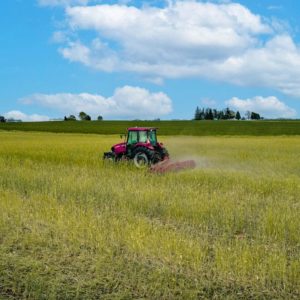 The roller-crimper is an implement developed by the Rodale Institute that flattens a standing cover crop and crushes the stem, mechanically killing it. The roller-crimper lets farmers reduce tillage and suppress weeds while using cover crops. It also lets them plant directly into a cover cropped field, known as “planting green,” then terminate the cover crop later.
The roller-crimper is an implement developed by the Rodale Institute that flattens a standing cover crop and crushes the stem, mechanically killing it. The roller-crimper lets farmers reduce tillage and suppress weeds while using cover crops. It also lets them plant directly into a cover cropped field, known as “planting green,” then terminate the cover crop later.
A challenge, however, is that farmers often find it hard to know the best time to roll-crimp cover crops for both maximal termination and minimal effect on soybean yield. Fred Abels, Jon Bakehouse, Keith Gorham and Kevin Veenstra investigated whether the timing of when they roll-crimp a rye cover crop (at rye anthesis versus at grain-filling) affected yield of soybeans that were no-till drilled into the rye cover crop prior to roll-crimping.
In-Row Roll-Crimping Cereal Rye Cover Crop Seeded in Twin-Rows Ahead of Soybeans
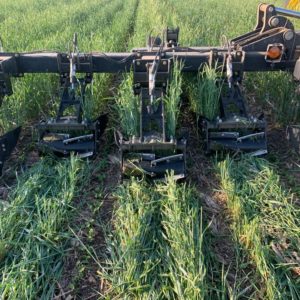 The in-row roller crimper is designed to roll-crimp only in the interrow between cash crop rows. Michael Vittetoe hopes that in-row roll-crimping will help him overcome some past issues he has had while planting his soybeans green, specifically by reducing shade stress on his soybeans.
The in-row roller crimper is designed to roll-crimp only in the interrow between cash crop rows. Michael Vittetoe hopes that in-row roll-crimping will help him overcome some past issues he has had while planting his soybeans green, specifically by reducing shade stress on his soybeans.
He designed a trial to test how in-row roll-crimping a cereal rye cover crop at boot stage, and then chemically terminating it shortly afterwards, affects soybean yield compared to chemically terminating the cover just after boot stage and letting the rye stand while partially shading the young beans. Michael was excited to see how these practices affect the need for weed management passes and soybean responses to field moisture conditions.
Tarping for No-Till Cover Crop Termination
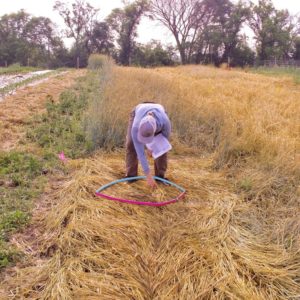 Tarping is a practice where farmers apply black tarps to the soil for weeks to months to prepare a bed before planting. The tarps block sunlight and heat up the ground underneath them, which kills weeds and cover crops, creates a stale seed bed, warms the soil and speeds up residue decomposition.
Tarping is a practice where farmers apply black tarps to the soil for weeks to months to prepare a bed before planting. The tarps block sunlight and heat up the ground underneath them, which kills weeds and cover crops, creates a stale seed bed, warms the soil and speeds up residue decomposition.
Farmers Emily Fagan and Hannah Breckbill of Humble Hands Harvest have been using tarping as a no-till bed prep tool, but they weren’t sure how long they needed to leave the tarps on to effectively kill a cover crop. To find out, they tested tarping for various lengths of time to see which is best at killing a cereal rye cover crop and curtailing growth of annual and perennial weeds. As part of the experiment, Emily and Hannah applied the tarps in mid-May and compared the effectiveness of leaving them on for one, two, three and four weeks.
Organic Fertilizer for Potatoes
 Potatoes have higher nutrient demands than many other horticultural crops and thus require extra care to maximize yield, quality and long-term soil health. A wide variety of organic fertilizer options are available to organic farmers, but it’s often difficult to know what fertilizer type and rate is best for maximizing yields and minimizing costs.
Potatoes have higher nutrient demands than many other horticultural crops and thus require extra care to maximize yield, quality and long-term soil health. A wide variety of organic fertilizer options are available to organic farmers, but it’s often difficult to know what fertilizer type and rate is best for maximizing yields and minimizing costs.
Kate Edwards, Jason Grimm and Terry Troxel each conducted trials to assess how commercially available organic fertilizers affect potato yields on their farms. Reflecting a goal shared by other participants, Jason said he undertook the trial “to improve our potato yield and help dial-in a nutrient management program for future seasons.”
Holganix Bio 800+ Compost Tea for Corn
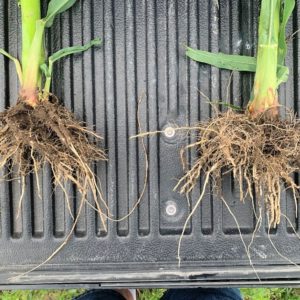 PFI cooperators, including Jack Boyer, have a long history of testing biological products that are marketed to complement or partially replace regular fertilizer or pest management programs, or both. These products frequently claim to boost crop yields, improve soil health and enhance ecosystem services like nutrient cycling. However, most research from PFI and other on-farm and academic researchers has shown that these types of products generally do not affect yield.
PFI cooperators, including Jack Boyer, have a long history of testing biological products that are marketed to complement or partially replace regular fertilizer or pest management programs, or both. These products frequently claim to boost crop yields, improve soil health and enhance ecosystem services like nutrient cycling. However, most research from PFI and other on-farm and academic researchers has shown that these types of products generally do not affect yield.
Holganix Bio 800+ is a commercial compost tea marketed as containing hundreds of different genera and species of soil microbes that can promote plant growth and enhance soil ecosystem processes, such as breaking down organic matter, cycling nutrients and fixing nitrogen. For this trial, Jack investigated whether adding Holganix Bio 800+ to his typical corn fertilizer program would boost corn yield. All acres in the trial received Jack’s typical fertilizer regimen. In the treatment plots, he added Holganix Bio 800+, applying it at manufacturer-recommended concentrations at corn planting.
Can We Reduce N Rates to Corn and Improve ROI?
In fields with long-term soil health-building practices, corn farmers compared yields, finances and greenhouse gas (GHG) emissions at their typical nitrogen rate with those observed at a reduced rate. Nineteen farmers performed 22 replicated strip trials testing their typical N rate against that rate reduced by 12%-50%. If farmers can maintain corn yields and/or save money at the reduced N rate, results might spark confidence to reduce (or at least question) fertilizer rates going forward.
On the other hand, if the reduced N rate lowers corn yields and loses money, farmers will still have gained valuable information: They can be more confident that their typical rate is the right rate for their farm, but maybe new long-term practices could help reduce it in the future.
Utrisha N Biological Nitrogen Supplement for Organic Corn
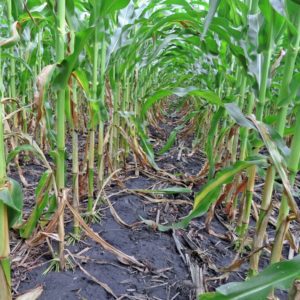 Utrisha N is a fertilizer amendment product that contains nitrogen-fixing bacteria and is marketed as increasing soil nitrogen supply to crops. It is designed to be foliar-applied to a wide variety of crops, including corn, and is certified organic by OMRI. These attributes piqued the interest of PFI cooperators, especially a group of organic farmers who have fewer nutrient management tools available to them.
Utrisha N is a fertilizer amendment product that contains nitrogen-fixing bacteria and is marketed as increasing soil nitrogen supply to crops. It is designed to be foliar-applied to a wide variety of crops, including corn, and is certified organic by OMRI. These attributes piqued the interest of PFI cooperators, especially a group of organic farmers who have fewer nutrient management tools available to them.
They wondered if Utrisha N could alleviate N limitation, increase yields and drive financial returns on their farms. Though many other interested cooperators could not participate due to the 2023 drought, Keaton Krueger, Scott Shriver and Noah Wendt did replicated strip trials testing whether adding Utrisha N to their typical fertilizer program provided any yield benefits on their organic (Scott and Noah) or conventional (Keaton) farms.
Brewers Spent Grain as a Soil Amendment for Eggplant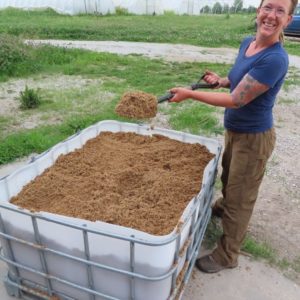
The spent grain left over after brewing beer, known as brewer’s spent grain or BSG, contains a lot of nutrients and organic matter that make it a potentially useful agricultural fertilizer. Kate Solko and Kyle Maxwell operate Root to Rise Farm on the same property as a brewery. They are excited about the potential of BSG as a soil amendment because using it would let them decrease off-farm inputs and find a use for an otherwise wasted product. To find out, they designed a trial to test how using BSG versus Sustane 8-2-4, their typical organic fertilizer, affects yield and disease pressure in an eggplant crop.

